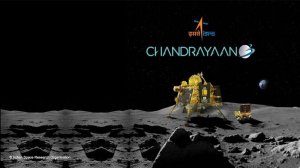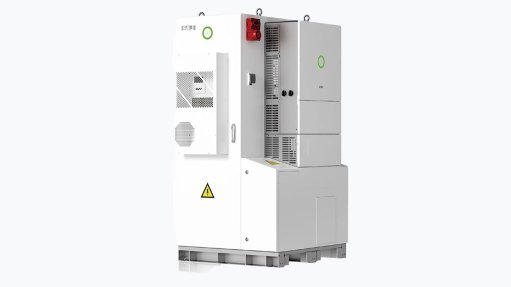Indian space agency reports that all systems are go on its historic Chandrayaan lunar mission


Artist’s impression of the Vikram lander and (right) the Pragyan rover on the lunar surface
Photo by Indian Space Research Organisation
The Indian Space Research Organisation’s (ISRO’s) history-making Chandrayaan-3 lunar mission has continued to go to plan with the activation of key experiments aboard the Vikram lander. This followed the successful deployment of the Pragyan rover on to the Moon’s surface, early on Thursday morning (South African time). (Chandrayaan is a Hindi and Sanskrit word that translates as ‘Moon vehicle’.)
“Chandrayaan-3 mission: All activities are on schedule,” stated ISRO in its most recent social media post. “All systems are normal.”
ISRO cited the activation of three experimental payloads on the Vikram lander. These were the Chandra’s Surface Thermophysical Experiment (ChaSTE), the Instrument for Lunar Seismic Activity (ILSA), and the Radio Anatomy of Moon Bound Hypersensitive ionosphere and Atmosphere (RAMBHA) instrument. ChaSTE will measure the surface thermal properties of the Moon, at Vikram’s polar landing site. ILSA will detect lunar seismic activity. RAMBHA will study the gas and plasma density near the Moon’s surface.
Vikram’s fourth payload does not require activation, being a passive Laser Retroreflector Array, which was supplied by the US National Aeronautics and Space Administration (Nasa). (ISRO’s mission control of Chandrayaan-3 is possible because interagency cooperation and partnerships means it can use both Nasa and European Space Agency tracking stations.)
The Pragyan rover carries two more experiments, the Alpha Particle X-ray Spectrometer, and the Laser Induced Breakdown Spectroscope. Both of these are intended to assess the mineralogical and chemical composition of the lunar surface.
The Chandrayaan-3 “propulsion module” – the spacecraft which carried the Vikram/Pragyan combination to the Moon – is also carrying an experiment. This is actually directed at the Earth, not the Moon, and is designated the Spectro-polarimetry of Habitable Planet Earth. This experiment was activated on Sunday and studies, from lunar orbit, the spectral and polarimetric measurements of the Earth.
The successful landing of Vikram (named in honour of Vikram Sarabhai, regarded as the father of India’s space programme) made India only the fourth country to successfully land a space probe on the Moon, after the (now dissolved) Soviet Union, the US and China. But, with this mission, India also became the first country to successfully land a probe at one of the Moon’s polar regions. Landing on the Moon is difficult; landing at one of the poles is especially difficult.
Pragyan (the name is Sanskrit and translates as ‘wisdom’ or ‘supreme intelligence’) has six wheels and a mass of 26 kg. Hopefully, Pragyan will be able to confirm the existence of water ice, believed to exist in the shadowed zones of craters in the Moon’s polar regions. The first evidence for such water ice concentrations was obtained by ISRO’s Chandrayaan-1 lunar orbiter, in November 2008. (Chandrayaan-2 was an unsuccessful attempt to place a lander on the lunar surface; instead, it crashed into the Moon in September 2019, due to a software problem.)
Vikram landed on the Moon at the start of a daytime period of a lunar day. On the Moon, a complete day lasts some 29.5 Earth days, meaning that the daytime period is just under 15 Earth days. Both Vikram and Pragyan are solar powered. Neither is expected to functionally survive the next dark and frigidly cold lunar nighttime, which starts in about 12 Earth days.
Comments
Announcements
What's On
Subscribe to improve your user experience...
Option 1 (equivalent of R125 a month):
Receive a weekly copy of Creamer Media's Engineering News & Mining Weekly magazine
(print copy for those in South Africa and e-magazine for those outside of South Africa)
Receive daily email newsletters
Access to full search results
Access archive of magazine back copies
Access to Projects in Progress
Access to ONE Research Report of your choice in PDF format
Option 2 (equivalent of R375 a month):
All benefits from Option 1
PLUS
Access to Creamer Media's Research Channel Africa for ALL Research Reports, in PDF format, on various industrial and mining sectors
including Electricity; Water; Energy Transition; Hydrogen; Roads, Rail and Ports; Coal; Gold; Platinum; Battery Metals; etc.
Already a subscriber?
Forgotten your password?
Receive weekly copy of Creamer Media's Engineering News & Mining Weekly magazine (print copy for those in South Africa and e-magazine for those outside of South Africa)
➕
Recieve daily email newsletters
➕
Access to full search results
➕
Access archive of magazine back copies
➕
Access to Projects in Progress
➕
Access to ONE Research Report of your choice in PDF format
RESEARCH CHANNEL AFRICA
R4500 (equivalent of R375 a month)
SUBSCRIBEAll benefits from Option 1
➕
Access to Creamer Media's Research Channel Africa for ALL Research Reports on various industrial and mining sectors, in PDF format, including on:
Electricity
➕
Water
➕
Energy Transition
➕
Hydrogen
➕
Roads, Rail and Ports
➕
Coal
➕
Gold
➕
Platinum
➕
Battery Metals
➕
etc.
Receive all benefits from Option 1 or Option 2 delivered to numerous people at your company
➕
Multiple User names and Passwords for simultaneous log-ins
➕
Intranet integration access to all in your organisation


















